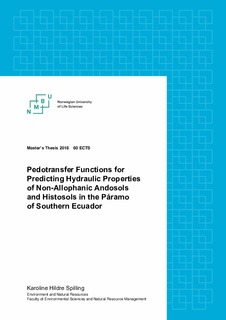| dc.description.abstract | The páramo grasslands of southern Ecuador is a source of continuous clean water supply for downstream communities and ecosystems all the way to the Amazonian rainforests or the Pacific coast. Still, knowledge about environmental processes and interactions in the páramo is limited. The dominating soils covering the páramo of south Ecuador are extremely organic volcanic ash soils that are characterized by low density and a strong water retaining ability. A deep understanding of the unique hydraulic properties of these soils is necessary for reliable modelling of the páramo hydrology. However, measurement of soil hydraulic properties is time-consuming, costly and impractical for large-scale modelling, and simple estimation of the necessary variables using pedotransfer functions (PTFs) often gives a good enough approximation of field conditions. In this thesis, PTFs for predicting six water retention points, available water capacity and saturated hydraulic conductivity were developed for Andosols and Histosols in the páramo of southern Ecuador. In addition, a selection of existing PTFs were evaluated on the dataset of this thesis. Two statistical approaches were used for the PTF development, ordinary least squares linear regression (OLS) and random forest (RF). Possible predictor variables were bulk density, organic matter, soil depth, slope, vegetation cover and soil type. Predictive performances of the resulting PTFs were overall satisfactory, and both the OLS and RF approach achieved test RMSEs below 0.05 in the low soil-water suction range. Predictions in the high suction range were less accurate, but test RMSEs were still below 0.08. The RF models predicted a little more accurately than the corresponding OLS models because of the ability of the RF approach at capturing complex interactions between variables, but the difference was not considerable. The test errors of the models predicting saturated hydraulic conductivity were not especially accurate, but they might be good enough as an alternative to field measurements. After testing the reliability of the functions on new data sets, the PTFs can become useful tools for hydrological modelling that helps us to get a better understanding of environmental processes in the páramo. | nb_NO |

